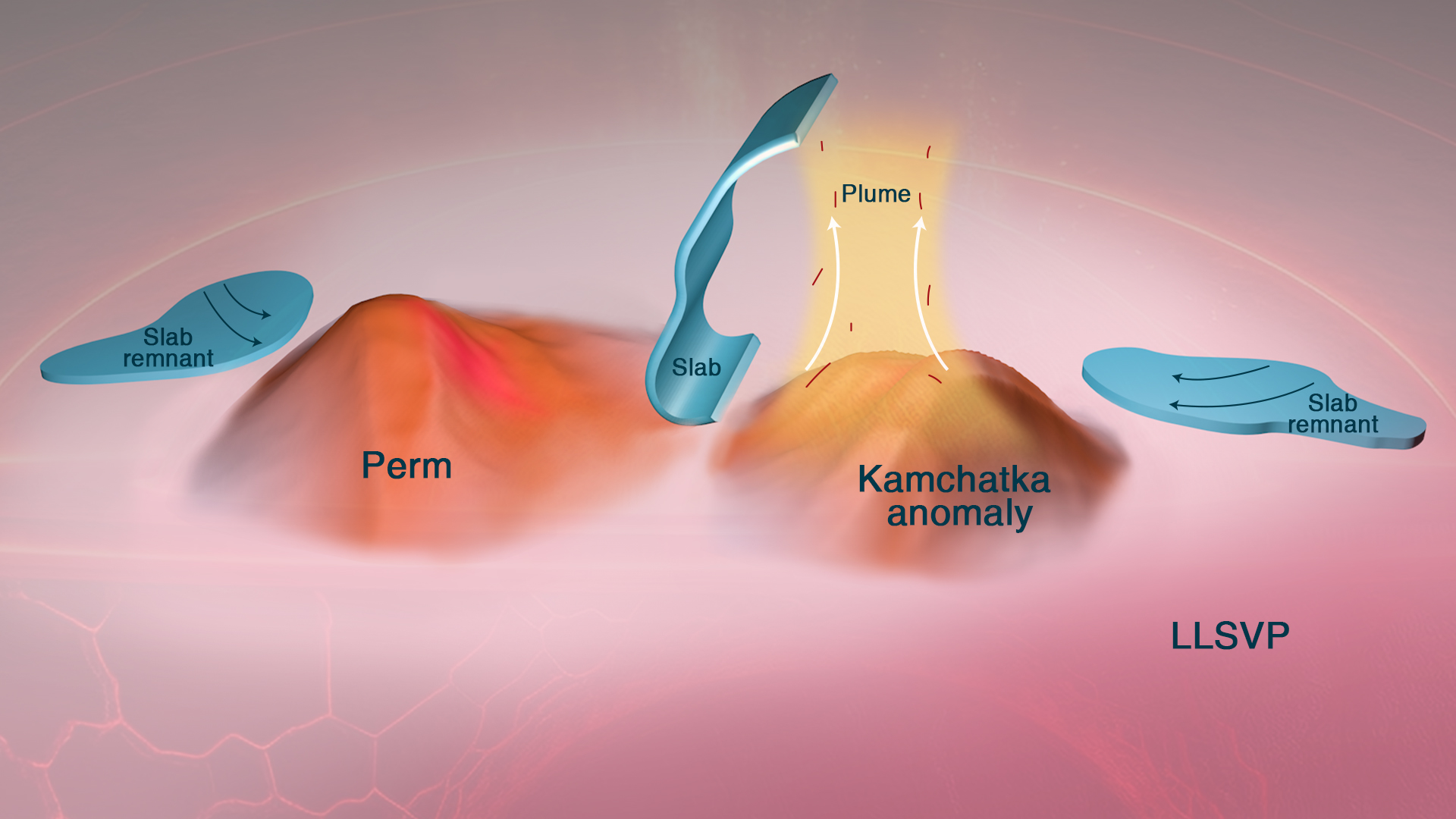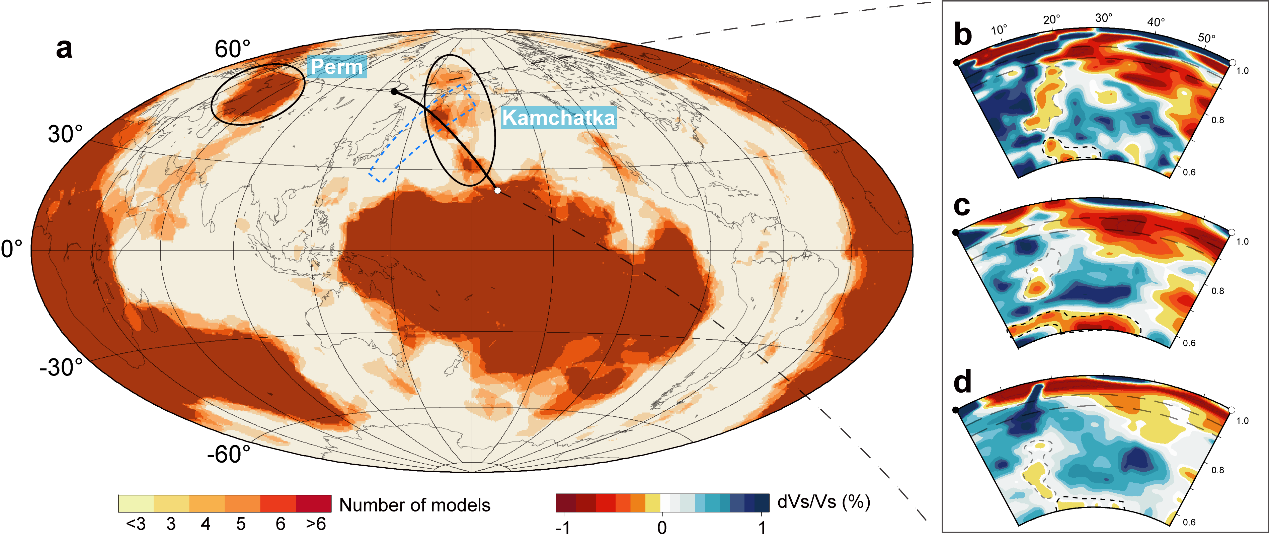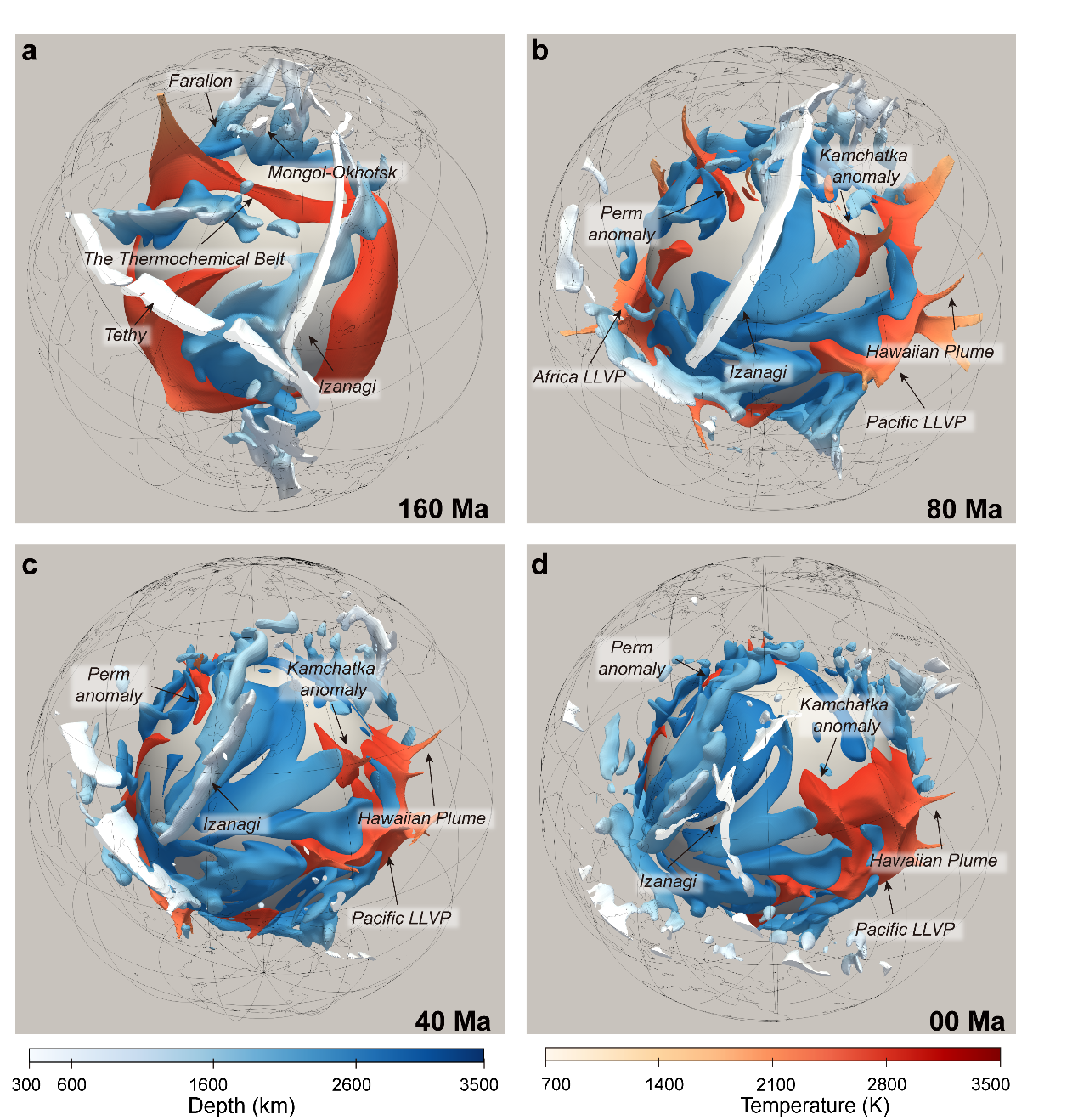The lower mantle has two significant structures known as large low-velocity anomalies (LLVPs) beneath the Pacific Ocean and Africa. These LLVPs cover approximately 30 percent of the core-mantle boundary (CMB) and exert a crucial influence on lower mantle dynamics. However, their stability has been a subject of controversy within the scientific community. Certain studies propose that these two LLVPs have maintained stability for hundreds of millions of years (Torsvik et al., 2010). Conversely, other research suggests that these structures may exhibit a more dynamic nature, akin to the continental motions observed on the Earth’s surface, involving processes of coalescence and dispersion (McNamara and Zhong, 2005).
Large igneous provinces (LIPs) predominantly occur at the margin of these LLVPs and serve as the primary surface manifestation of their presence. Consequently, the locations of LIPs have been utilized to investigate the stability of LLVPs over geological time. However, recent studies have revealed the challenges associated with discerning the extent of mobility exhibited by LLVPs solely based on the paleogeographic distribution of LIPs (Flament et al., 2022). Furthermore, there exist certain LIPs, such as the Columbia River Basalt associated with the Yellowstone mantle plume, which are geographically distant from LLVPs, leaving their connection to lower mantle structures uncertain.

Associate Professor Jiashun Hu’s research group from the Department of Earth and Space Sciences at the Southern University of Science and Technology (SUSTech) has recently published a study that focuses on the Kamchatka anomaly located at the base of the lower mantle. It investigates the evolutionary history of intermediate-scale thermochemical anomalies and their relationship with large low-velocity anomalies (LLVPs).
Their work, entitled “Segregation of a thermochemical anomaly and coalescence with a large low-velocity province”, has been published in the international journal Nature Geoscience.
Exploring lower mantle dynamics with new models
Based on these problems noted above, Jie Zhang, a Ph.D. student in Associate Professor Jiashun Hu’s group at SUSTech, together with Professor Daoyuan Sun at the University of Science and Technology of China (USTC), adopted an alternative approach. They shifted their focus to intermediate-scale (~1000 km) thermochemical anomalies, aiming to study their evolutionary history. By combining existing tomography models with geodynamical numerical simulations, they aimed to better constrain the linkages between thermochemical anomalies in the lower mantle and the dynamical processes occurring there.
By overlaying existing tomography models, the team identified multiple intermediate-scale low-velocity anomalies at the base of the lower mantle (Fig. 1). Among these, the most notable are the Perm anomaly, situated beneath Eurasia, and another isolated intermediate-scale anomaly, termed the Kamchatka anomaly, located beneath Kamchatka. Seismic waveform analysis was employed to infer velocity gradients at the margins of the Perm anomaly, suggesting it is a thermochemical anomaly (Lekic et al., 2012). Similarly, waveform analyses detected a low-velocity body beneath Kamchatka (He et al., 2014). However, the nature, origin, and evolution of this anomaly remain highly controversial.

Figure 1. Voting map of global tomography models (a) and profiles of different tomography models (b-d)
From Siberia to the Pacific: Anomaly’s journey
The team further employed a global mantle convection model under paleogeographic constraints to investigate the origin and evolution of the Kamchatka anomaly. The model successfully predicted a thermochemical structure that mirrors the scale and geography of the seismologically observed Kamchatka anomaly. It also illustrated the life cycle of the thermochemical anomaly beneath the Kamchatka Peninsula from its birth to its demise.
During the Early Mesozoic, an ancient thermochemical anomaly formed beneath Siberia due to the triple subduction pinch-outs of the Tethys, Farallon, and Mongolian-Okhotsk (Fig. 2a). By the Cretaceous period, this anomaly was split into two distinct parts by the Izanagi Plate (Fig. 2b). The western fragment evolved into the Perm anomaly observed today, while the eastern fragment became the Kamchatka anomaly, migrating southeastward (Fig. 2c).
Currently, the Kamchatka anomaly is situated beneath the northwestern Pacific Ocean, and is in the process of merging with the LLVPs under the Pacific Ocean (Fig. 2d). The researchers reworked the simulations after modifying parameters such as the viscosity and density of the thermochemical anomalies, as well as the viscosity of the slabs and the surrounding mantle. Despite these adjustments, they obtained a roughly consistent evolutionary course for the Kamchatka anomaly. Additionally, most models predicted the eruption of a mantle plume during the eastward movement of the Kamchatka anomaly in the Late Cretaceous.
This mantle plume, originating from the Kamchatka anomaly, is thought to have formed a large igneous province at the surface. This province may have eventually subducted beneath Kamchatka and re-entered the mantle. The existence of this mantle plume remains highly debatable due to the lack of observational data. More information from geological and seismological studies is necessary to verify its presence.

Figure 2. Evolution of the Kamchatka anomaly as demonstrated by the numerical model
Plate reconstruction has significant implications for understanding lower mantle dynamical processes, yet considerable uncertainty persists in reconstructing the plate history of the Northwest Pacific Ocean. This uncertainty arises mainly because approximately 90 percent of the Panthalassa has been fully subducted. Traditional plate reconstructions often depict traditional “Andean”-type subduction beneath Eurasia. However, recent studies suggest a more complex plate history, favoring various types of intra-oceanic subduction since the Cretaceous or Middle Jurassic. Further studies tested different plate reconstructions and found that the evolutionary history of the Kamchatka anomaly remained consistent regardless of the reconstruction method used. This bolsters the robustness of the described evolutionary process.
The results of this study indicate that the Perm anomaly and the Kamchatka anomaly share a common origin, underscoring the significance of intermediate-scale thermochemical anomalies in regulating deep mantle processes. Their evolution highlights several key aspects, including the generation of mantle plumes and mass transfer between thermochemical anomalies. Additionally, the findings suggest that the LLVP beneath the Pacific Ocean is relatively young and still undergoing assembly. The modeling also reveals the complex interactions between thermochemical anomalies and subducting slabs, emphasizing the close coupling between deep mantle dynamics and surface tectonics through the formation of mantle plumes.
Jie Zhang is the first author of the paper. Associate Professor Jiashun Hu is the corresponding author, and co-authors include Professor Daoyuan Sun.
This research was supported by the Young Scientist Project under the Key R&D Program of the Ministry of Science and Technology and the National Natural Science Foundation of China (NSFC).
Paper link: https://www.nature.com/articles/s41561-024-01459-5
To read all stories about SUSTech science, subscribe to the monthly SUSTech Newsletter.
Proofread ByAdrian Cremin, Yingying XIA
Photo ByDepartment of Earth and Space Sciences